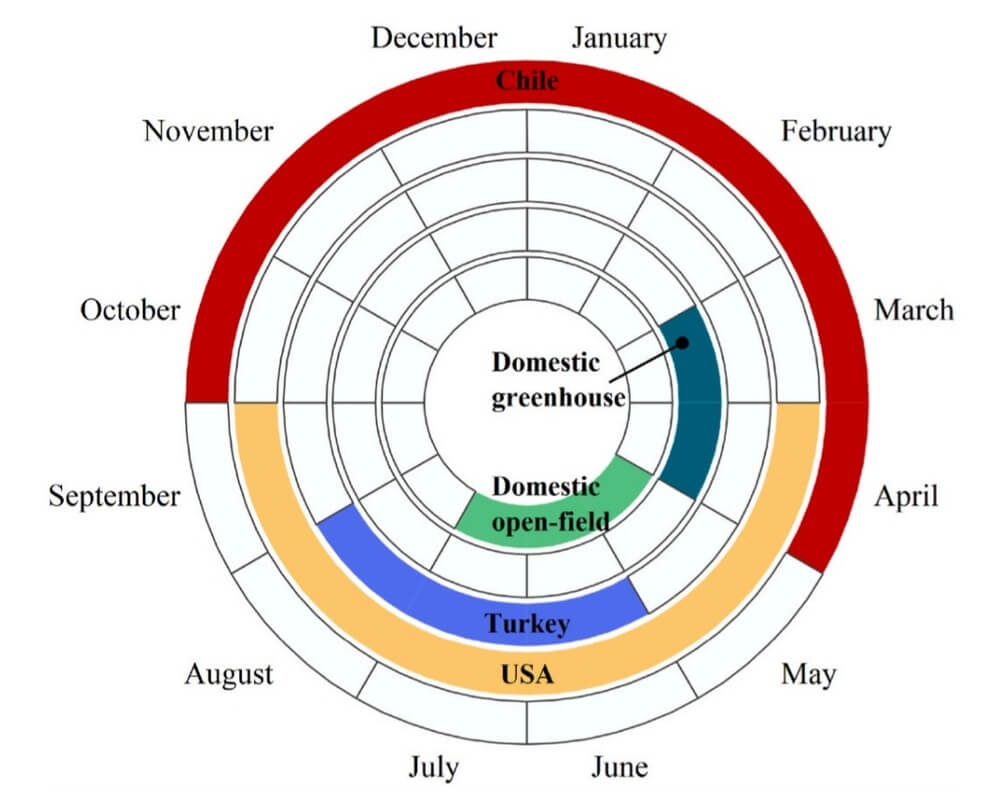A recent study conducted by Chilean universities reveals that foliar application of phosphorus could be a crucial factor in improving the quality and condition of sweet cherries. This result is particularly relevant for growers in southern Chile, an area that faces the challenge of soils with low availability of this essential nutrient.
The study evaluated the effects of foliar phosphorus application on cherry trees grown under plastic covers. The results showed that this agronomic strategy has a significant impact on several fruit quality parameters, both at harvest and during storage.
The research focused on diseases that affect fruit shelf life. Phosphorus application significantly reduced the incidence of certain postharvest diseases, with effects particularly evident during the storage of harvested cherries.
Evaluation of postharvest parameters
In this study, results obtained in the postharvest phase of cherries were analyzed, based on three treatments tested with different doses of phosphorus, and deterioration was observed after 35 days of storage, assessing parameters such as incidence of pitting, “orange peel,” dehydration, and internal browning.
In detail, the study compared three different foliar phosphorus application treatments to evaluate their impact on cherry quality:
- T1 – Control: No phosphorus application. Reference group for comparison with other treatments.
- T2 – Low phosphorus dose: Foliar application of 1 L/ha of a phosphoric acid-based fertilizer (H₃PO₄).
- T3 – High phosphorus dose: Foliar application of 2 L/ha of the same phosphoric acid-based fertilizer (H₃PO₄).
Results obtained
According to the scientific publication, foliar phosphorus application led to:
- 70% reduction in “pitting,” visible as small depressions on the fruit skin.
- 56% decrease in “orange peel,” a disorder that gives the fruit a rough texture.
- 31% reduction in fruit dehydration.
- 29% decrease in internal browning, an issue that compromises the visual appearance of cherries.
These results suggest that foliar phosphorus application represents a promising tool for the Chilean fruit industry, helping growers improve not only the quality of their cherries but also to preserve their condition during transport and storage.
Operational recommendations and conclusions
The study emphasizes, however, that treatments are not universal. The value of this result lies in its specificity: it was designed for the soil conditions of southern Chile and for the cherry variety ‘Regina’. This type of targeted research is fundamental to move beyond generic recommendations and provide precise and effective solutions to reduce losses throughout the entire postharvest chain.
To effectively apply this knowledge in the field, a three-step approach is recommended:
- Comprehensive soil analysis: A detailed edaphological analysis is essential to identify specific deficiencies, such as phosphorus. This makes it possible to go beyond standard recommendations and build a plan tailored to the real needs of the soil.
- Customized fertilization plan: This is not a generic program, but a detailed strategy that defines which products to use, in what doses, and at which key fruit development stages.
- Continuous technical monitoring: Professional support over time is important, adapting the fertilization plan to climatic and agronomic conditions. This helps optimize crop quality and protect investment.
Sources: González-Villagra, J., Muñoz-Alarcón, A., Pirce, F., Müller, E., & Ribera-Fonseca, A. (2025). Effects of Foliar Phosphorus Application at Harvest and Postharvest in Sweet Cherry (Prunus avium L.; cv. Regina) Produced in Southern Chile.
Horticulturae, 17(9), 1052. https://doi.org/10.3390/horticulturae11091052
Juan Carlos Garrigues
Image source: SL Fruit Service
Cherry Times - All rights reserved










